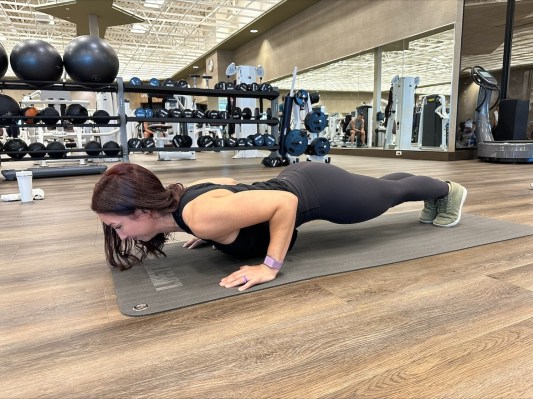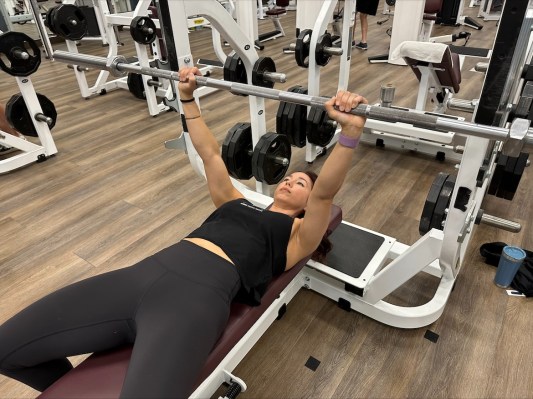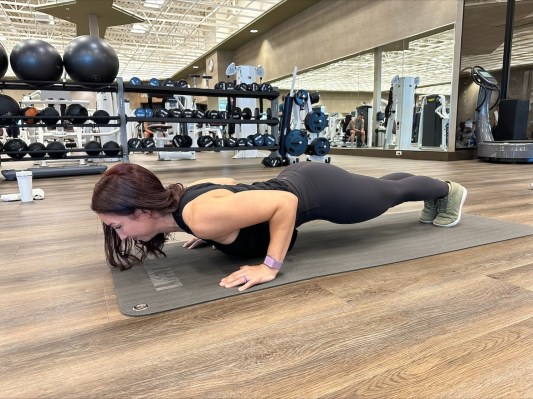You’ve likely been doing push-ups since childhood, but you may be less familiar with bench presses. However, both can be valuable tools in building a strong upper body—plus other muscles, like your core.
The good news is that you can incorporate both into your routine, but there may be certain cases when you want to opt for one over the other.
Here’s everything you need to know about the push-up vs. bench press, how to properly do these exercises, the muscles they target, and the pros and cons of each.
In This Article
Experts In This Article
Push-ups
Here’s exactly how to do a push-up with correct form. Start with two to three sets of 10 to 15 reps. To advance, try four sets of 10 reps.

- Start in a high plank position, with your hands shoulder-width apart, fingers pointing forward. Your body should be in a straight line.
- Keeping your head aligned with your back, bend your elbows and lower yourself down toward the floor.
- Keep your elbows pointed back toward your hips, not flared or straight out.
- Try to lower down until you almost touch the ground (or go as far as you can go without sagging your hips or flaring your elbows).
- Press upward until your arms are fully straight and you are in the starting position.
Muscles worked
Push-ups primarily target the following muscles:
- Pectoral muscles (chest)
- Anterior deltoids (front shoulders)
- Triceps (back of your arms)
- Stabilizer muscles in your core, shoulders, and upper back
“Push-ups target the same muscles as bench press, but involve the core muscles even more,” says Anna Taylor, CPT, a USA Weightlifting certified coach and personal trainer at Life Time. “They are great for individuals who need to work on stabilizing the abdominals and back muscles, while improving upper body strength.”
“[Push-ups] can be done anywhere, improve upper-body strength, and enhance core stability and posture.” —Anna Taylor, CPT
Pros
The push-up is a comprehensive workout that’s also very accessible.
“They can be done anywhere, improve upper-body strength, and enhance core stability and posture,” Taylor says.
Even though you can’t do much to vary the weight in a push-up (like you would in a bench press), you can still try variations to mix up your workout.
“Push-ups offer numerous variations to increase or decrease difficulty and target different muscle groups,” says Jack Coxall, a UKSCA accredited strength and conditioning coach, Level 3 personal trainer, and co-founder of Fitness Lab. “Variations include standard push-ups, wide-grip push-ups, narrow-grip push-ups, decline push-ups, incline push-ups, diamond push-ups, and plyometric or explosive push-ups.”
Cons
Because push-ups rely primarily on body weight for resistance, they may not be challenging enough for more advanced training goals.
“Some individuals may also experience discomfort in the wrists, especially if they have wrist mobility issues or poor form,” Coxall says.
You may also find push-ups challenging or uncomfortable if you have shoulder or elbow injuries. Plus, you can exacerbate pain if you’re a beginner and don’t use the correct form, so it’s important to follow the steps listed above closely.
“Incorrect form can cause lower back, wrist, and shoulder strain or pain,” Taylor says.
Bench presses
Here’s exactly how to do a bench press with correct form. Start with two to three sets of 10 to 15 reps. To advance, try three to four sets of 6 to 8 reps.

- Lie on a bench, about eye level under a barbell.
- Place your hands on the barbell, a little wider than your shoulders. Your thumbs should be wrapped around the bar.
- Lift the bar off the rack, keeping your shoulders away from the ears and elbows at a 45-degree angle.
- Move the bar down slowly to your chest as you inhale.
- As you press the bar back up, exhale while keeping your feet stable on the ground.
Muscles worked
Like push-ups, bench presses work the following muscles:
- Pectoral muscles (chest)
- Anterior deltoids (front shoulders)
- Triceps (back of your arms)
- Stabilizer muscles in your core, shoulders, and upper back
“A bench press targets mainly the triceps, shoulders, and chest muscles,” Taylor says. “They’re great for individuals looking to improve overall strength and lift heavier loads in a training program.”
“[Bench presses] are great for individuals looking to improve overall strength and lift heavier loads in a training program.” —Anna Taylor, CPT
Pros
Bench presses are great for improving your upper-body strength, metabolism, and bone density.
“You can also use other equipment for horizontal pressing, like dumbbells, kettlebells, bands, and machines,” Taylor says.
As you progress, you can also increase the weight you use to build your strength.
“Bench presses allow for greater load progression and may be more effective for building maximal strength and muscle mass, particularly if using heavy weights,” Coxall says.
Not only can you vary the equipment used, but you can also adjust your form to target different muscles.
“The bench press offers variations such as flat bench press, incline bench press that targets the upper chest, decline bench press that targets the lower chest, and various grip widths like wide grip or close grip,” Coxall says.
Cons
You may get less range of motion with bench presses compared to push-ups.
“Bench presses on a flat bench may not fully engage stabilizer muscles as much or provide a full range of motion compared to push-ups, especially if not performed with proper form,” Coxall says.
And of course, you also need gym equipment to do a bench press.
“Bench presses require a bench and weights, which may not be readily available for everyone,” Coxall says.
You may also need a spotter. If you’re a beginner, you might find yourself not using your full body to stabilize the core.
“If the weight is too heavy, you may use your shoulders too much rather than your chest, which can cause injury,” Taylor says.
Improper form or lifting too heavy can also lead to chest or elbow injuries, Coxall adds.
The Bottom Line
Both bench presses and push-ups can be great for beginners to more advanced gym-goers. Push-ups may be better for a better core workout, while bench presses allow you to add more weight over time (which may be important for your specific workout goals).
“Bench presses are best to improve maximal strength when focusing on strength and performance,” Taylor says. “While push-ups are great for general fitness, they also may be added as a warmup exercise prior to bench pressing or after as an accessory to build shoulder stability and core strength.”
In other words, you don’t have to choose one over the other. To build a powerful strength routine for your upper body, consider doing bench presses as your main lift for the day, followed by push-ups as add-on movement.
Source: Well and Good






